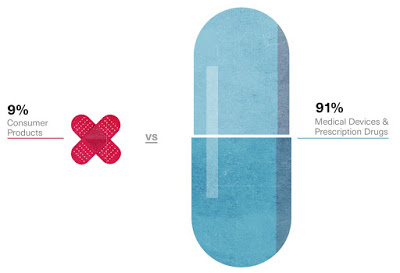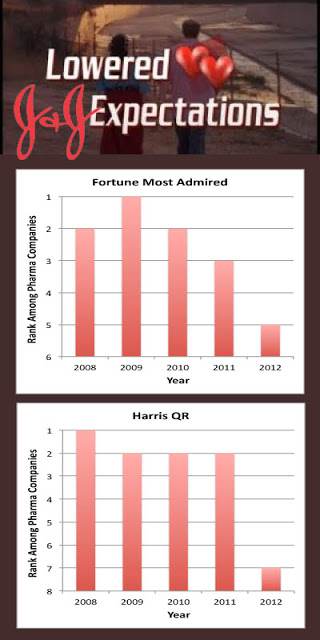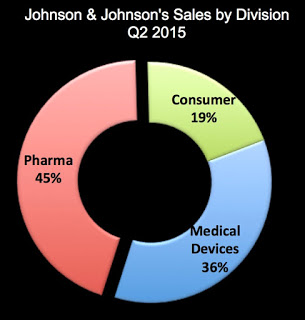JNJ has always positioned itself as a “consumer” products company, but its main business is pharmaceutical drugs and medical devices. According to a Q2 2015 financial statement (here), Rx products account for 45% of the company’s sales, medical devices 36%, and consumer products – for which the company is loved – only 19% (see chart on left).
In Q1 of 2012 the percentages were 37%, 40%, and 23% (see here).
I am interested in this because of data regarding J&J’s PROFITS that I came across in a article by journalist Steven Brill today in The Huffington Post Highline titled “America’s Most Admired Law Breaker.”
That article is part of a 15-part “DocuSerial” detailing how Johnson & Johnson took an anti-psychotic drug, Risperdal, initially intended only for the treatment of psychotic disorders, and put it in the hands of children and the elderly in violation of FDA restrictions. Of course, I’ve written about J&J’s illegal activities many time now here on Pharma Marketing Blog (read, for example, “How J&J’s Alex Gorsky Tried to Negotiate a Smaller DOJ Fine“).
But what about J&J’s profits? Where do they come from? What’s the impact on the company’s reputation?
As the Huffington Post Highline article points out “With consumer products from Band-Aids to baby powder, Neutrogena to Rogaine, Listerine to Visine, Aveeno to Tylenol and Sudafed to Splenda, Johnson & Johnson is the biggest and, according to multiple surveys, most admired corporation in the world’s most prosperous industry—healthcare. But the real money—about 80 percent of its revenue and 91 percent of its profit—comes not from those consumer favorites, but from Johnson & Johnson’s high-margin medical devices.”
 |
| Click on image for an enlarged view. |
Obviously, the medical device/Rx drug side of the business is more profitable than the consumer product side, which has more competition. J&J, as well as other pharma companies, has been selling off its consumer business. As it does so and as more of its profits come from devices and drugs, J&J will also sell off its beloved image, which is already happening as shown in the chart below.










![6 Digital Tools at the Center of Healthcare Digitalization [INFOGRAPHIC]](http://ec2-54-175-84-28.compute-1.amazonaws.com/pharma-mkting.com/wp-content/uploads/2021/04/6DigitalTools_600px-100x70.jpg)




